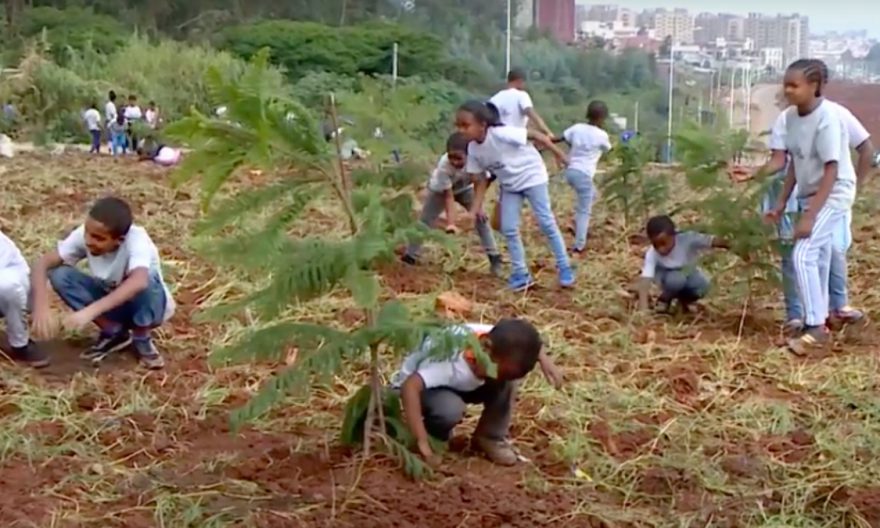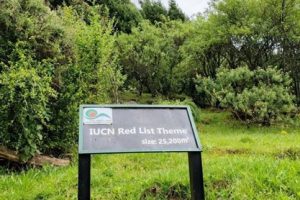
Tree seedling preparation is key to supporting the effort of afforestation and tackling deforestation. Prior awareness and careful seedling preparation are crucially important since they protect and enrich the soil in which their crops and forage plants grow, produce various items that they need on a day-to-day basis, or can sell.
Afforestation indeed plays an imperative role in the socio-economic development of communities, as trees planted on farms provide timber, fuelwood, fodder, fruits, medicine, windbreaks, and a whole range of other economic and environmental benefits.
Taking this fact into consideration, Ethiopia has launched a green legacy initiative. The initiative is promoted by Ethiopian Prime Minister Abiy Ahmed in 2019 to curb the effects of climate change and deforestation. For the past consecutive years, Ethiopians have planted billions of seedlings.
According to Prime Minister Abiy, the initiative of planting tree seedlings has been prepared to avert flooding, food insecurity, environment-related conflicts, and other adverse effects. It also focused on restoring the country’s green coverage, eliminating erosion and pollution, reducing conflicts arising due to environmental degradation and reduction of natural resources, and measures to support Ethiopia’s agricultural sector and economy.
Scholars and studies have agreed that the green legacy initiative, currently, has increased the need to plant tree seedlings in the nation. Because, it was difficult, however, for the communities to access the tree seedlings that they want to plant at the right time, in the right quantities, and of high quality. Hence, the initiative has so far played an imperative role in providing seedlings to the communities.
The initiative indeed set targets to see 20 billion trees planted across the nation by 2022. Accordingly, during the 2019 plantation campaign over 23 million people and during the 2020 plantation period over 27 million Ethiopians have participated in the plantation. Even in 2021, Ethiopia has planted about 6 billion tree seedlings. Although the initiative set 20 billion targets in four years, in 3 years, more than 18 billion seedlings have been planted across the nation.
This year, seedling preparations are underway to implement the green legacy initiative. Prime Minister Abiy Ahmed revealed that seedling preparations are underway to meet the Green Legacy Initiative target of the fourth year. The Initiative launched some three years ago aims at preventing the effects of climate change and deforestation in Ethiopia by planting 20 billion seedlings in four years.
The upcoming rainy season will mark the fourth year of the green legacy initiative. “Seedling preparations are currently underway to enable us in meeting and exceed our four-year target, the Premier stated.
The preparations are held on-farm and community tree nurseries. Such nurseries can be owned and managed by individual farmers, self-help groups, schools, churches, and a range of other local institutions. They provide income-generating opportunities, act as models for further nursery development, provide seedlings more cheaply to planters, and can raise the particular species that local people are interested in.
However early tree seedling preparation needs applaud, but it also requires precautions and various activities. These activities should be managed properly to achieve improved results and not to repeat any blunders committed in the past four years. The preparation must also give due attention to tree seedlings that have the capacity to mitigate climate change effects.
Ethiopian Biodiversity Institute Crop and Horticulture Director Ato Wubeshet Teshome told The Ethiopian Herald that Ethiopia is endowed with indigenous drought-resistant species or crops which are better at mitigating climate change. They also adopt the weather condition of the country.
Hence, tree seedling selection and preparations should give emphasis on production, mitigation of climate change, the resilience of diseases, and so on. It should be also indigenous. Because the tree could be used for various purposes that include improving the agriculture sector, reforestation, water resource management, and eco-tourism projects, he added.
Ethiopian Biodiversity Institute Research, Dissemination and Project Implementation Director and Botanist Tesfaye Awas (Ph.D.) told The Ethiopian Herald that Ethiopia has 6027 species plants and over 2000 plants have been used for natural medicinal purposes and 10 percent of the plants are endemic. They are only used in Ethiopia.
More than 70 percent of the population also depends on traditional medicines for their healthcare, and about 95 percent of the preparations are made from plant origin. Nonetheless, these traditional medicine plants have faced various challenges such as environmental degradation, deforestation, recurrent drought, and various anthropogenic activities.
Furthermore, habitat destruction, over-exploitation, erosion, lack of effective regulation, and so on are threatening the medicinal plants of biodiversity natural resources of the country. Medicinal plants are affected by unplanned growth and over-exploitation.
The green legacy initiative, therefore, should include tree seedlings that can be used for medicine.
Since the planted trees are eaten by both humans and animals, they should also be productive, and they have to be planted in their natural places where the nursery site is located, Tesfaye explained.
Mitigating climate change is important to increase food production, soil protection, increased fertility, and the nation’s biodiversity. It also helps the nation to increase Gross Domestic Product (GDP) which brings social and economic benefits to the country. However, climate change affects the GDP of developing countries like Africa.
A senior environmental expert from the Economic Commission for Africa (ECA), Linus Mofor, noted that “African economies are losing on average 5 percent of GDP because of climate change, increasing up to 15 percent in some countries.”
Climate change indeed negatively rising unemployment rates, inflation, trade imbalance, and falling real wages play a role, too. Each of these factors can negatively affect the GDP of a nation, leading to a loss of revenue for businesses, enterprises, and so on.
However, African countries have shown “great leadership” on climate action, it is imperative to facilitate and create a conducive setting for African youths to participate in climate-related investment to turn them into successful and impactful global businesses that address climate change issues, according to Mofor.
Indeed, this rainy season will mark the fourth year of the nation’s green initiative. Seedling preparations are currently underway to enable the country in meeting and exceed its four-year green legacy initiative target. To implement the initiative effectively, the government, media, and stakeholders should work on creating awareness, better site preparation, obtaining seedling trees on time and pre-planting care, when to plant, how to plant, avoid common mistakes that occur during planting, post-planting care, and long-term care.
BY EPHREM ANDRAGACHEW
THE ETHIOPIAN HERALD SUNDAY EDITION 20 MARCH 2022





